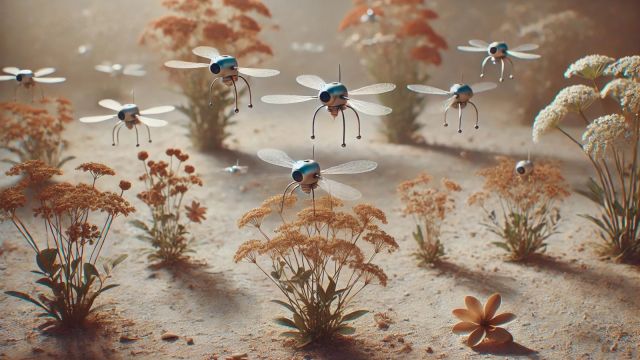MIT scientists build tiny robotic insect drones to aid pollination (original) (raw)
 The tiny robots have flapping wings that imitate the movements of bees, and they weigh under a gram. (AI-generated image for representation: OpenAI)
The tiny robots have flapping wings that imitate the movements of bees, and they weigh under a gram. (AI-generated image for representation: OpenAI)
The day when robots perform pollination may not be far off. Scientists at the Massachusetts Institute of Technology (MIT) are currently working on robotic insects that could soon fly out of mechanical hives and pollinate rapidly, boosting the production of fruits and vegetables on an unimaginable scale. If this is proven to be efficient, these tiny robots could increase crop yield exponentially, without causing any harm to the planet.
The idea of robots as pollen carriers is not entirely new. The robots reportedly developed earlier were not durable and lacking the speed and aerial versatility seen in bees and other real insects. Also, scientists have been making strides in artificial pollination with methods like mechanical pollination.

According to the research paper titled ‘Acrobatics at the Insect Scale: A durable, precise, and agile micro–aerial robot’ published in the Journal of Science Robotics, the scientists revealed that they were able to build a design with features that address the limitations of mechanical pollination. The tiny robots reportedly have flapping wings that imitate the movements of bees, and they weigh under a gram. The new model is agile and showcases the advancements in small-scale robotics.
When it comes to insects, they are agile and precise because of their tiny frame and fast neuromotor control. “They perform impressive acrobatic maneuvers when evading predators, recovering from wind gusts, or landing on moving objects. Flapping-wing propulsion is advantageous for flight agility because it can generate large changes in instantaneous forces and torques,” read the abstract of the paper.
While insects showcase exceptional flexibility and fatigue resistance, micro-aerial vehicles (MAVs) have significantly lower lifespans. Most MAVs can only hover for less than 10 seconds or can follow simpler paths at slower speeds. The scientists at MIT have developed a 750 mg flapping-wing MAV that showcased improved lifespan, speed, accuracy, and agility.
Based on the research paper, these robots can hover for 1,000 seconds (over 16 minutes). This is 100 times longer than other smaller-sized robots. Additionally, the robots can fly complex paths at a good speed – 30 cm per second. The robot can climb quickly and can also do fast flips, even much faster than some insects and larger drones. In simple words, the tiny robots can have endurance and agility similar to insects.
© IE Online Media Services Pvt Ltd
- Tags:
- Robotics